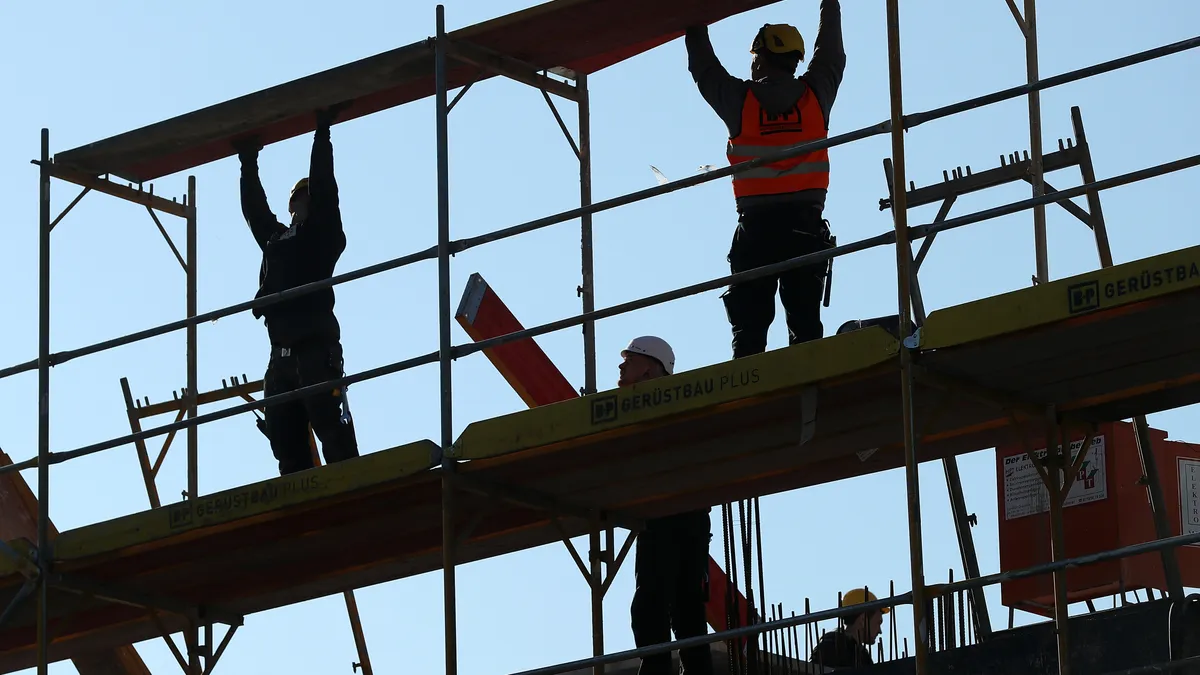After two years of pandemic-related fits and starts, builders are set for a busy spring.
Construction and engineering spending reached $1.57 trillion in July 2021, according to Deloitte, and revenue growth will likely accelerate in 2022. In a survey of over 500 U.S. executives and other senior leaders in the field, Deloitte also found that 92% characterize their business outlook as somewhat or very positive, 23% higher than the previous year.
But this spring isn't all roses and sunshine. Supply chain constraints and rising costs, in some cases exacerbated by pent-up COVID demand, are making sourcing materials and sticking to budgets more difficult.
"It just very hard for an industry that typically operates on a small margin and has to go through competitive bidding process to accurately predict what they're going to be paying or, as important, when those materials are going to show up," said Brian Turmail, vice president of public affairs and strategic initiatives at the Associated General Contractors of America. "It's a really challenging time for what was already a challenging time."
Supply chain, inflation woes
Problems sourcing materials, and the rising prices of those materials continue to weigh on many construction sectors. In its March Construction Quarterly Survey, the National Multifamily Housing Council found that 89% of respondents were facing construction delays. They also found that 92% of their members repriced deals over the last three months, with increases averaging 25%.
"Continued volatility of both available materials as well as pricing changes and significant cost impacts" are mostly to blame, said Paula Cino, NMHC vice president for construction, development and land use policy. "It doesn't seem to be a blip anymore."
Mark Luegering, senior vice president and chief operating officer at Cincinnati-based Messer Construction, said that they're seeing estimates go up 10% to 20% over original calculations due to supply issues and inflation. The company is reworking budgets and doing value engineering to keep jobs within budgets, and clients are willing to cut back and "make adjustments in materials they need," he said. "Owners have been very flexible and understanding."
"It's a really challenging time for what was already a challenging time."

Brian Turmail
AGC vice president for public affairs and strategic initiatives
Jodi Rennie, vice president and regional general manager for Turner Construction Co.'s Pennsylvania, Delaware, West Virginia and South Jersey operations, said that Turner, like other firms, is facing supply chain issues, but the firm has managed to mitigate some of those pressures because of a strong supply chain division with more than 300 people — a division it began more than a decade before the pandemic.
"They all focus on supply chain and where are hiccups in supply chain," she said, and to see future challenges before they become current problems. Turner also shares that information with clients, and determines if they can pre-purchase materials and "maybe store it somewhere to get our material to the site long before we need it."
Pent-up demand
While winter can affect building schedules, most contractors have learned to plan for it, and build their schedules accordingly, said Turmail. But a slightly more mild winter combined with pent-up COVID demand has pushed up schedules, which has exacerbated supply chain issues, particularly with concrete.
"We've got different parts of the country where contractors are being told there's no concrete," he said. He's received notices from groups in Georgia, Alabama and Arizona about the problem.
"The above usual demand for concrete products during the winter depleted most concrete firms' stockpile," he said. "They have downtime for maintenance and now don't have anything left."
AGC is continuing to see "waves of supply chain issues," he said. For example, where concrete is a problem now, it was roofing materials in the fall and winter.
Construction isn't immune to global conflict either. Russia's invasion of Ukraine is also impacting the industry, even in smaller material segments. "We're hearing sporadic things [about delays] like tile products that have clay in them because Ukraine is a big exporter of clay and tile," he said.
The labor problem
Labor continues to be a challenge. According to the Deloitte report, 52% of engineering and construction executives said that their company is facing a severe labor and talent shortage.
Vaccination rates for construction workers continue to be low (46.2% nationally, according to the Center for Construction Research and Training). However, it's been manageable so far, said Luegering, because they have enough workers that they can keep vaccinated workers on projects where owners require vaccines, like many healthcare projects do.
Because an OSHA vaccinate mandate for companies with over 100 workers was deemed unconstitutional in January, it hasn't been as major a disruption as it could have been, he added, though "still a potential concern with federal and military" projects, he said, because of continuing court battles over federal and military vaccine mandates.
However, the COVID-19 pandemic no longer seems to be a major contributing factor. NHMC began its Construction Quarterly Survey – then called the COVID Construction Survey — at the start of the pandemic. Cino said this most recent report is the first time the coronavirus has not been considered a significant challenge, and is no longer causing delays and shutdowns.
"That really has been stripped," she said. "Now we're in a place where we're facing broad economic headwinds."




















